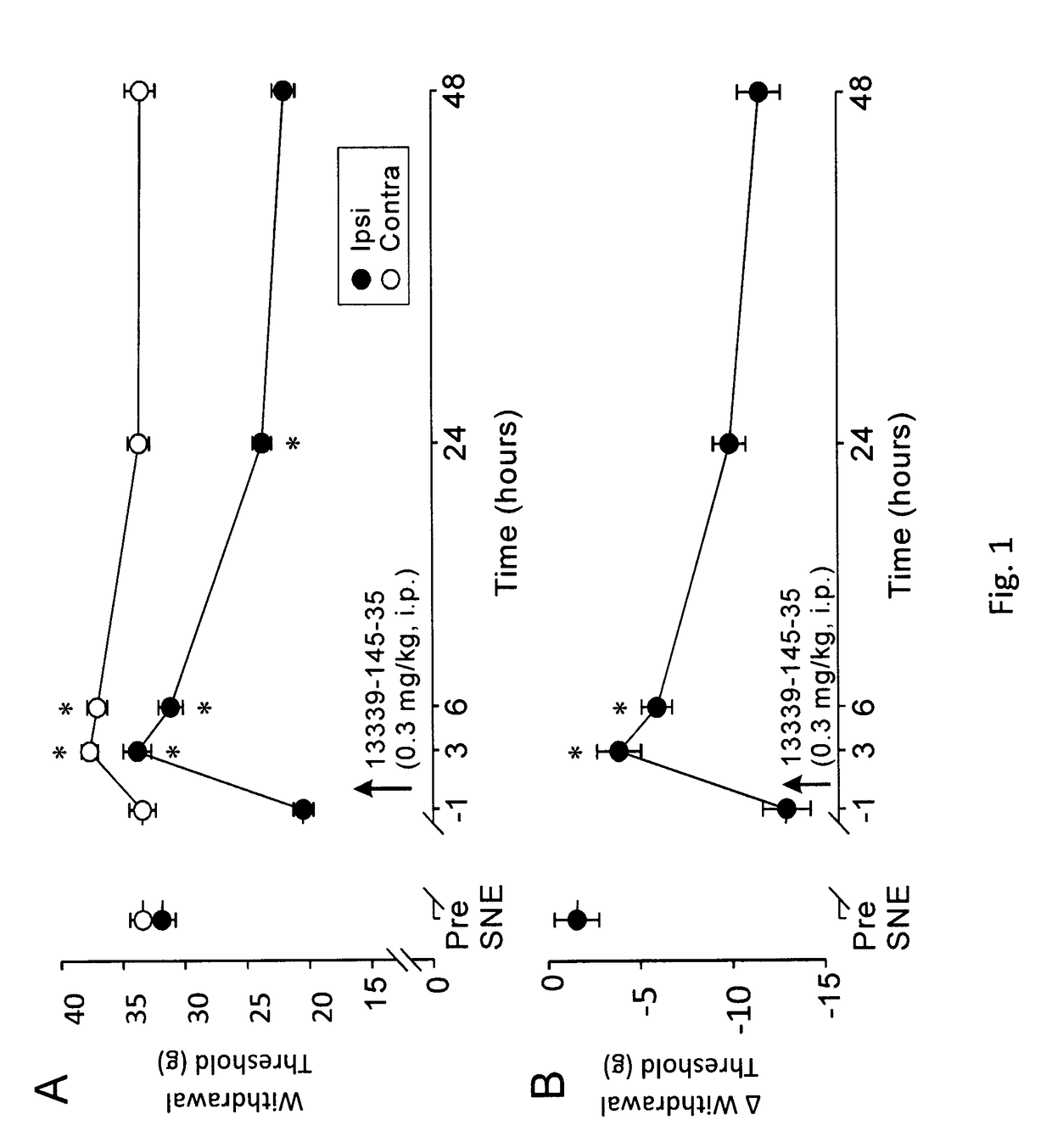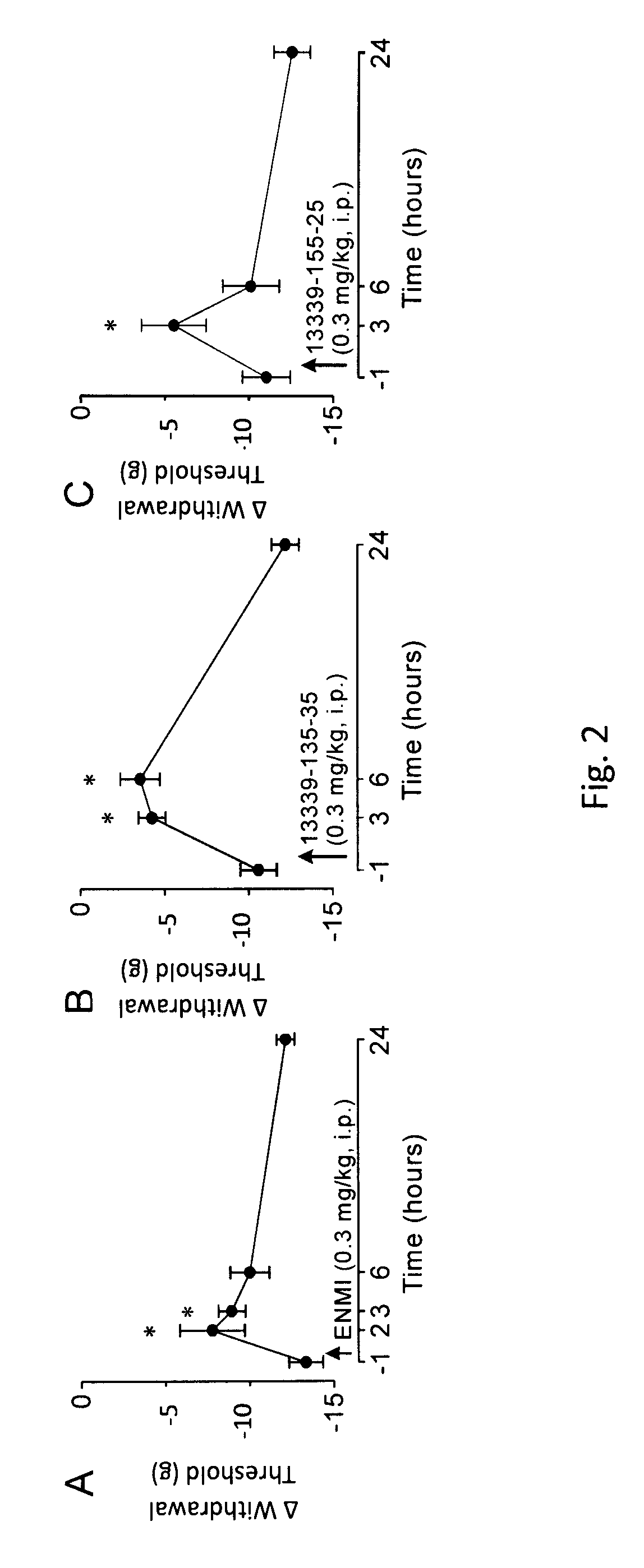Peripherally-acting cannabinoid receptor agonists for chronic pain
a cannabinoid receptor and agonist technology, applied in the field of chronic pain agonists, can solve the problems of reversible impairment of cognitive and performance tasks, cb1rs on the central terminals of primary afferents remains controversial, and the precise mechanism by which cannabinoids reduce intraocular pressure has yet to be elucidated,
- Summary
- Abstract
- Description
- Claims
- Application Information
AI Technical Summary
Benefits of technology
Problems solved by technology
Method used
Image
Examples
example 1
In Vitro Assays
[0192]1) CB1 / CB2R Binding Assays.
[0193]Detailed radioligand displacement assays (using the well-characterized CBR agonist CHFCP55940 as the radioligand) were conducted to determine the affinity (Ki) of the test compounds for CB1R and CB2R as has been previously described by our group112,113. Heterologous competition binding assays were performed to calculate receptor affinities. Unlabeled SR141716 or SR144528 were used as appropriate controls for non-specific binding (NSB) in the assay. Calculation of the equilibrium dissociation constant (Ki) was performed using the Cheng-Prusoff equation.
[0195]The calcium 3 dye assays were run according to manufacturer's specifications (http: / / www.moleculardevices.com / Products / Assay-Kits / GPCRs / FLIPR-Calcium.html) and as reported in our previous publications112,113. Briefly, wells of black clear-bottom 96-well tissue culture-treated plates are seeded with 20,000 cells the afternoon before assay. The day of...
example 2
Indene Synthesis
General Methods
[0202]1H and 13C NMR spectra were run on a Bruker Avance 300 MHz or a Varian Unity Inova 500 MHz NMR spectrometer. Mass spectra (MS) were run on a Perkin-Elmer Sciex API 150 EX mass spectrometer. High resolution mass spectra (HRMS) were run on a Waters Synapt G2 Q-TOF mass spectrometer in high-resolution mode. Column chromatography was carried out using a Teledyne Isco Combiflash Rf system with RediSep Rf silica cartridges. Preparative thin layer chromatography was carried out using Analtech TLC Uniplates (silica gel, 1000 μm, 20×20 cm). High pressure liquid chromatography was performed using a system consisting of a Waters 1525 pump unit, driven by Empower software, and a Waters 2487 detector. Microwave chemistry was carried out using a CEM Discover SP microwave with 10 mL irradiation tubes.
Synthesis of ENMI 4-{2-[(1E)-1-(Naphthalen-1-ylmethylidene)-1H-inden-3-yl]ethyl}morpholine (26)
[0203]
[0204]4-[2-(1H-Inden-3-yl)ethyl]morpholine (30) (2.82 g, 12.3 ...
example 3
Indole Synthesis
[0205]
Synthesis of 6-Fluoro-3-[(naphthalen-1-yl)carbonyl]-1-pentyl-1H-indole (40)
[0206]Sodium hydride (207 mg, 60% in oil, 5.18 mmol) was added to DMF (20 mL) at 0° C. and the mixture stirred for 10 minutes. A solution of 6-fluoro-3-[(naphthalen-1-yl)carbonyl]-1H-indole (36) (750 mg, 2.59 mmol) in DMF (10 mL) was added dropwise over 5 minutes and the resulting solution stirred at 0° C. for 30 minutes. A solution of 1-bromopentane (431 mg, 2.85 mmol) in DMF (1 mL) was then added dropwise to the stirred mixture. Cooling was continued for an additional 10 minutes before allowing the solution to warm to room temperature and stir overnight. The reaction was quenched with water (75 mL), and EtOAc (50 mL) was added. The mixture was shaken and the organic layer removed. The aqueous layer was then extracted with additional EtOAc (50 mL). The organic layers were combined, dried over Na2SO4 and the solvent removed under reduced pressure. The residue was purified over silica gel...
PUM
| Property | Measurement | Unit |
|---|---|---|
| volume | aaaaa | aaaaa |
| volume | aaaaa | aaaaa |
| volume | aaaaa | aaaaa |
Abstract
Description
Claims
Application Information
 Login to View More
Login to View More - R&D
- Intellectual Property
- Life Sciences
- Materials
- Tech Scout
- Unparalleled Data Quality
- Higher Quality Content
- 60% Fewer Hallucinations
Browse by: Latest US Patents, China's latest patents, Technical Efficacy Thesaurus, Application Domain, Technology Topic, Popular Technical Reports.
© 2025 PatSnap. All rights reserved.Legal|Privacy policy|Modern Slavery Act Transparency Statement|Sitemap|About US| Contact US: help@patsnap.com



